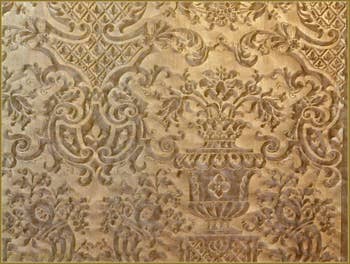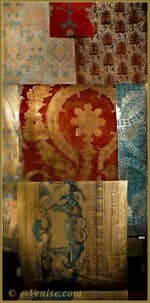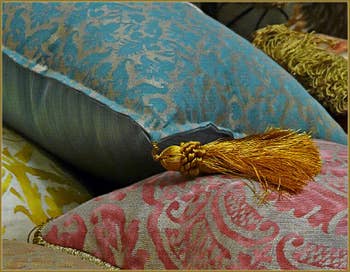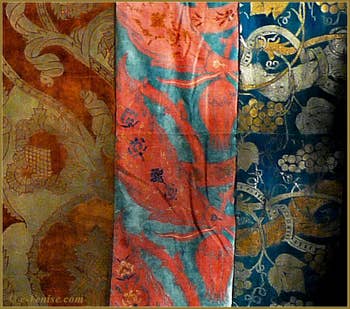Art Painters | Music | Literature | Video | Pictures
Painters Tintoretto | Titian | Canaletto | Fortuny | Albrecht Dürer |
Fortuny Martinengo Orfei | Theatre | Clothes Fabrics | Photography Costume
Coloured Satin, Brocades, Damascene Fabrics: The sources of Mariano Fortuny's inspiration in the depths of the past
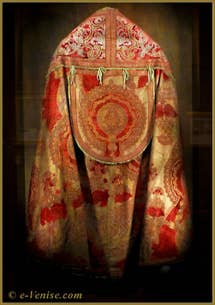
Mariano Fortuny cape During his intense theatrical activity, Mariano Fortuny was regularly confronted with the problem of actors' costumes.
According to his conception of the total work of art, costumes were important auxiliaries, and the problem of choosing costumes had two aspects: Finding and caring for the style of costume models that could best convey the atmosphere of the works represented.
This required precise historical knowledge combined with great artistic sensitivity.
Taking into account the reflection of light on fabrics, in anticipation of the visual effect of costumes on stage and the construction of reflectors.
This is how Mariano Fortuny used satin coloured and treated in different ways to make his indirect light reflectors.

Fabric Fortuny “Carnavalet” From Coptic fabrics to Oriental carpets, via brocades and damascene fabrics from the renaissance originating from his father's collection and then added to by his mother, Mariano had a direct, almost physical knowledge of the most diverse fabrics.
This familiarity was a precious aid to his research and artistic activity, and to the creation of new fabrics.
Always admiring the splendours of great civilisations, archaeological discoveries also attracted Mariano Fortuny's full attention, and he would take up motifs from ancient fabrics or reproduce them.
“In 1907, fragments of ancient printed fabrics found in Greece prompted me to research printing processes and, my wife and I, founded a printing workshop in Palazzo Pesaro-Orfei using our methods.”
Fortuny

Fabric Mariano Fortuny
Mariano Fortuny Printed Fabric Designer
It was in 1907 that Mariano and Henriette first experimented with printing on large rectangular pieces that could be used as shawls or stoles, with decorative geometric and plant motifs inspired by ceramics found in Crete, in Knossos.After using the ancient method of wooden stamps, which did not produce the aesthetic results expected, they tried Japanese stencils, “katagamis” they were among the first to use them in the West.
The katagamis technique enabled polychrome prints to be made by breaking down the final design into several different stencils, one for each colour.
In the West, they were replaced by metal or cardboard covers to obtain larger, but expensive and impractical, matrices.

Fabric Fortuny “Richelieu” Presentation of the first Fortuny garments in Berlin in 1907: the silk shawls “Knossos;
On November 24, 1907 in Berlin Mariano Fortuny presented 15 models of silk shawls at the Hohenzollern Kunstgewerberhaus.
Fifteen different shawls, 4.50 m long and 1.10 m wide, edged with Greek lacework, stylised scrolls, palm trees, rosettes, lotus flowers, lions, chimeras, griffins, inspired by the Minoans, the Babylonians, the Egyptians, the Phoenicians...
Christened châles Knossos by Henriette and Mariano Fortuny, they are printed in black and gold on a white background.
And presented by dancer Ruth Denis who shows the audience how to drape them around the body, while retaining their freedom of movement.
The Knossos shawls marked the beginning of the magnificent careers in the fashion world of Henriette and Mariano Fortuny, who returned to Venice in December 1907 to work together on printed fabrics.
However, Mariano continued to occupy himself with theatre: in 1908, commissioned by Hugo Von Hoffmanstahl, he produced two models for “The Singer and the Adventurer”.
And, at the Louvre theatre exhibition, he presented three maquettes relating to works by Wagner and a copy of his cupola.
The patents and successes of Mariano Fortuny, the Delphos Dress
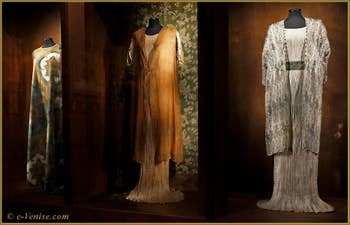
Robes Mariano Fortuny “Delphos” Mariano Fortuny had been particularly taken by the beauty of the statue of the Aurige of Delphi, and wanted to make dresses with vertical pleats in the fashion of Ancient Greece.
The Ionian chiton (kitôn) depicted on ancient funerary stelae, was a light, stiff linen tunic that “did not fall naturally” the vertical pleats made up for this defect, while giving it a certain elegance.
To achieve this, it was necessary to find a more elaborate method than hand pleating or “nail pleating” which, in addition to the time spent, did not guarantee good quality pleating: the pleats did not hold very well despite the starch, and everything distorted.

Robe Fortuny “Delphos” He developed an effective pleating device, and filed a new patent with the Office National de la Propriété Industrielle in Paris.
1909: Patent for a “Apparatus for pleating silk fabrics”, filed in June, to be followed by that for a “Women's silk garment”, named “Delphos”, in November.
This women's silk garment, pleated by its pleating apparatus, is the famous Delphos dress! It could be worn with a matching silk gauze jaquette.
Theatre stars launch Fortuny fashion
The 1910s found inspiration in the exotic and the past.And, as a man of the theatre Mariano Fortuny had looked after the costumes of Sarah Bernhardt and Eléonora Duse, “ the Duse” whom he had known since 1901, and since then she had come to visit him regularly at Campo San Benedetto.
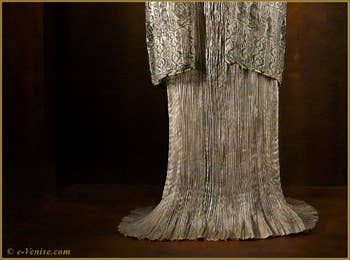
Robe “Delphos” Fortuny Mariano had created extremely refined garments for them: the marvellous Delphos dresses, which were worn next to the skin and hugged the shapes while veiling the contours of the body, undulating with the slightest movement accompanying it with its silk reflections.
Worn in theatres and salons by the most famous actresses, all women were fascinated by these dresses, which miraculously combined the elegance and refinement of an ultra-feminine gown with the comfort offered by its incredible suppleness.
One size fits all for unique dresses that adapted to each woman, since they could stop at the ankles, or hide them by flaring out on the floor like a flower corolla.
The magic of the Delphos dress did not escape the genius sensitivity of writers and novelists, who combined the beauty of their heroines with the preciousness and mystery of these dresses closed on either side by a line of glass fibulae of Murano, matching their colour, which hugged the shapes of the body and undulated with every movement, fascinating the eye with incessant reflections.
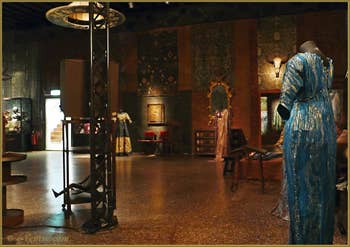
Dress “Delphos” The Delphos dress responded with charm and elegance to the trend at the beginning of the 20th century to free the female body in its movements (abandoning the corset that constricted the hips and bust from the waist to the chest) and to get rid of superfluous ornamentation, at the same time as architecture was adopting rational and progressive criteria, emphasising practical and functional comfort.
Polychrome printing system on fabrics
Mariano Fortuny also studied very closely the pigments he wanted to apply to fabrics, in order to enrich his chromatic range by employing exotic colours extracted from organic materials using techniques of old masters such as Titian and the TintorettoMany artists such as Gustav Klimt, Pierre Bonnard, Émile Bernard, Maurice Denis, John Singer Sargent, are said to have consulted him on the subject.
He succeeded in perfecting the method of printing katagamis by inventing a system different from Western industrial processes such as the cylinder machine, which assumed a high level of technology.
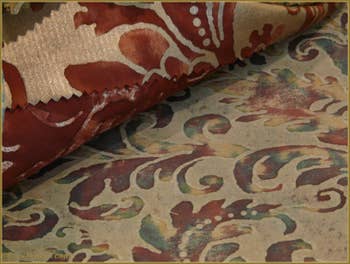
Tissus Mariano Fortuny His process made it possible to obtain large printed surfaces that could either be stretched on a frame or used in the form of continuous strips.
This was the equivalent of a screen-printing method combined with the mechanical system of the continuous strip, whose matrices made from very fine silk fabrics were soaked in gelatine on which the design was created with an alkaline bicarbonate solution.
This new system was both more economical and more practical than all the others, since the large matrices eliminated the problems associated with repeating patterns.
In 1910 he filed a new patent in Paris for his “System for dyeing and printing fabrics”.

Detail of a fabric The spread of Japanese-style decoration brought something new to the fashion for printed fabrics, not only through the modular use of elements, but also through a trend towards abstraction and the abandonment of relief effects by replacing gradations and sfumato with the clear, clean separation of colours.
These exotic contributions were not seen simply as models to be imitated, but rather as the starting point for a genuine figurative exercise through which Western taste could be purified.
This was also reflected in the abandonment of woven fabrics, which had a certain relief, in favour of prints with their flat surfaces and all the possibilities for choosing and combining motifs and colours.
Cultures from all over the world, inexhaustible sources of Mariano Fortuny's original creations
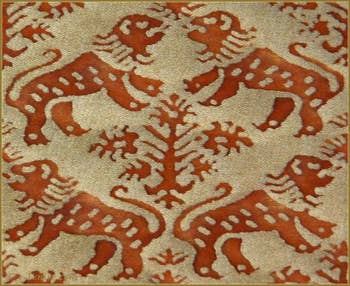
Fabric “Richelieu” Fortuny Quickly realising the wealth of possibilities offered by printing, Mariano Fortuny abandoned Greek fashion to give free rein to his imagination, diversifying his production as much as possible.
And through his theatrical activities, he proved to be an excellent decorator as well as a great stylist, working with three types of fabric: silk and silk velvet for clothes, and cotton for interior decoration.
For interior decoration, he drew inspiration from Western motifs from the Renaissance and Baroque periods, and sometimes from Persian and Arab carpet motifs.
The chiselling of weapons, helmets and shields in the Ottoman style provided Mariano Fortuny with as many possible styles, as he rediscovered the techniques and skills of the ancients and identified the most beautiful motifs to be found anywhere in the world.
This artist was particularly gifted at capturing the essence of different cultures, recombining them and transposing them into his work.
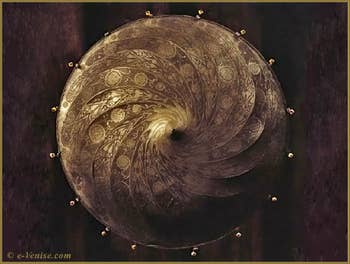
Mariano Fortuny silk lamp For example, he took wide-brimmed Asian hats and Saracen shields as models, turning them upside down to make hanging lamps.
When the motifs and their configuration remained fairly conventional, it was because Mariano was trying above all to create chromatic effects.
His talent as a painter was undoubtedly not unrelated to his success in using print alone to create effects of thickness and chiaroscuro specific to woven fabric.
Shawls, dresses, burnous and djellabas
And Mariano Fortuny followed the same approach to clothing.Between 1910 and the twenties he kept the same models of loose, supple, high-waisted dresses that had spread throughout Europe, which he limited to decorating or enriching with other elements.
Archaic Chinese, Coptic and North African motifs, as well as the assimilation of liberty designs, characterised this period, which focused on the creation of evening or ceremonial styles, such as liturgical garments, inspired by 16th-century Venice.
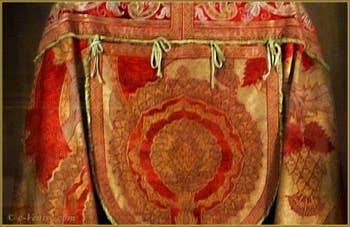
Mariano Fortuny cloak Cited in the works of Marcel Proust, these dresses were more than just dresses, let's just say they transformed those who wore them into characters.
And the beautiful socialites could in turn afford this luxury and this dream.
These toilets were not just any décor, replaceable at will, but a given and poetic reality, like the weather, like the special light at a certain time.
Of all the dresses or dressing gowns worn by Madame de Guermantes, the ones that most seemed to respond to a specific intention, to be endowed with a special meaning, were the dresses that Fortuny made according to ancient drawings from Venice.
Is it their historical character, or rather the fact that each one is unique that gives them such a special character that the pose of the woman wearing them as she waits for you, chatting with you, takes on an exceptional importance, as if this costume had been the fruit of long deliberation and as if this conversation stood out from everyday life like a scene from a novel.
Mariano Fortuny Burnou Arabe In Balzac's, we see heroines purposely dressing up in this or that gown on the day they are to receive a particular visitor.
Today's toilettes don't have as much character, except for Fortuny's dresses.
There can be no vagueness in the novelist's description, since this dress really exists, and the slightest drawings are as naturally fixed as those of a work of art.
Before putting on this one or that one, the woman had to make a choice between two dresses, not roughly the same, but each profoundly individual, and which could be named. But the dress didn't stop me from thinking about the woman.”
Marcel Proust - À la Recherche du Temps Perdu
Remember that during his first visit to Venice with his mother in May 1900, the young Marcel Proust had been received by Cécilia Fortuny at the Palazzo Martinengo thanks to his friend Reynaldo Hahn.
Cécilia housed Reynaldo Hahn and his cousin Marie Nordlinger in her palazzo, because Reynaldo was the brother of the second wife of Raimundo y Madrazo, Mariano's uncle.
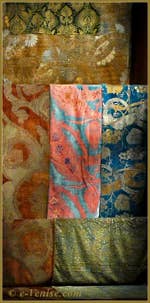
Fortuny Fabrics As she had done for Henri de Régnier, and as she did a little later for Paul Morand, it is highly likely that following this rite she would have shown her collection of fabrics to Marcel Proust, and that he would also have had the pleasure of admiring them in the company of his friends and Mariano Fortuny himself.
Reynaldo Hahn composed for Ballets Russes by Serge de Diaghilev the music for “ Dieu Bleu” of 1912, written by Jean Cocteau in collaboration with Federico de Madrazo y Ochoa (Raymundo's son).
A great admirer of John Ruskin, Marcel Proust and his friends would visit Venice with his book “The Stones of Venice” in hand.
Later, when this novelist evoked the clothes of Mariano Fortuny resurrecting the past splendours of Venice, it was also as an art and architecture enthusiast with a perfect knowledge of his subject that he wrote:
As for the toilets, what pleased him most at the time was everything Fortuny was doing.
These dresses by Fortuny, one of which I had seen on Mme de Guermantes, were the ones Elstir was talking about when he told us about the magnificent clothes of the contemporaries of “Carpaccio” and the Titian, had announced to us the next appearance, rising from their ashes, sumptuous, for everything must return, as it is written on the vaults of St. Mark, and as proclaimed, drinking from the marble and jasper urns of the Byzantine capitals, by the birds that signify both death and resurrection.
Fortuny fabric detail As soon as the women had started wearing them, Albertine had remembered Elstir's promises, she had wanted some, and we were to go and choose one.
Now these dresses, if they weren't real antique dresses, in which today's women look a bit too costumed and which it's nicer to keep as collector's items (I was also looking for some for Albertine), didn't have the coldness of a pastiche, of a fake antique.
In the manner of the sets by Sert, Bakst and Benoist, who at the time evoked the most beloved periods of art in Russian ballets - using works of art imbued with their spirit and yet original - these Fortuny dresses, faithfully antique but powerfully original, appeared like a set, with even greater evocative power than a set, since the set had yet to be imagined, the overcrowded Venice of the Orient where they would have been worn, of which they were, better than a relic in St. Mark's shrine evocative of the sun and the surrounding turbans, the fragmented, mysterious and complementary colour.
Everything had perished in those days, but everything was reborn, evoked to link them together by the splendour of the landscape and the swarming of life, by the fragmented and surviving emergence of the dogaresses' fabrics.”
Marcel Proust - The Prisoner
Mariano Fortuny and the spirit of the Renaissance
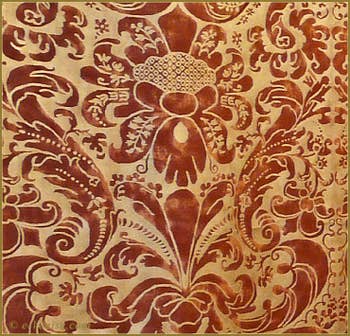
Fabric “Caravaggio” There is no sterile nostalgia in the invocation of the arts and the beauty of times gone by, but the revival of it through the creation of a new work that reminds us of it like a reminiscence, or that reveals it in our present, which it illuminates.
The rediscovered beauty, or the revelation of the timeless, then appears to us as a rebirth.
Mariano's fabrics and dresses are both the recovery and the fragmentary return of the vanished ephemeral.
Medieval fashion was thus at the origin of a dress, called “Eleanora” in honour of the Duse, consisting of two panels of printed velvet falling straight down in front and behind and joined at the sides by pleated satin.
The paintings of Vittore Carpaccio were the main sources of inspiration for the capes with their triangular bonnets, especially for the patterns and colours.
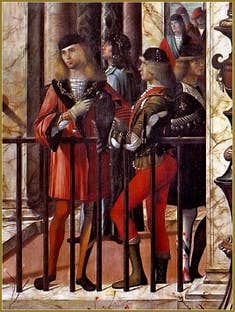
Vittore Carpaccio Particularly “the arrival of the ambassadors”, where two young men wearing splendid jackets can be seen in the foreground to the left of the painting, from which Mariano drew much of his inspiration in making fabrics for his coats.
Spanish velvet was also given pride of place, as Mariano owned a few old examples; he was also inspired by the beautiful dress of Eléonore of Toledo, painted in the 16th century by Il Bronzino (Angelo di Cosimo di Mariano).
And, to resurrect Venice's glorious past, Mariano Fortuny also took up the palettes of other great masters such as Tintoretto, but especially Paul Veronese and Titian, whose portraits of leading figures provided him with valuable information on the fashions of the day, and as many models for theatrical costumes.
He had painted a partial copy of “Cleopatra's Banquet” by Giambattista Tiepolo, in which the belle is dressed in a sumptuous gown that also became a valuable source for reproducing the beauty of rich Italian silk velvet fabrics.
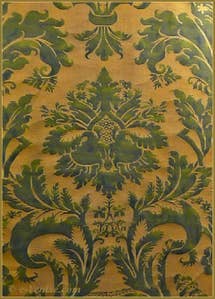
Fabric “Glicine” Fortuny It was the spirit of the renaissance that was resurrected thanks to this painter, nicknamed the little Leonardo, who like the geniuses of that era, was a universal spirit for whom there were no minor arts.
Like them, Mariano Fortuny was fascinated by the arts of Greek antiquity, by science and technology, particularly the work with pigments to obtain the brilliance of colours for his fabrics.
As in the past, he sourced his silk fabrics from India, China, and Japan.
The pigments he used came from all over the world: cochineal from Mexico for the carmine red, indigo from India, straw from France for the yellow... and the famous rotten egg white from China, which was used as a fixative for gold and silver, which was then polished with amber.
He mainly used natural and delicate colours: red, green, blue, ochre, brown, pink, orange, which he juxtaposed harmoniously.
To reproduce the old braided wefts of gold or silver thread, he added copper powder for the gold effect, or aluminium for the silver effect.
It was Henriette herself who prepared the dyes, or mixtures, since they resulted from skilful blends whose secrets only she and Mariano knew.
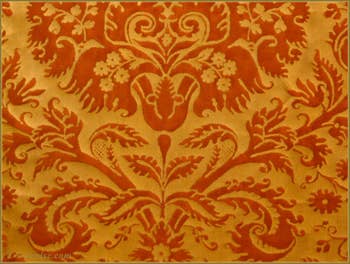
Fabric “de Medici” And Venice rediscovered all the alchemy of its former colours.
Totally indifferent to his century, its novelties and its aesthetic modernity, Mariano Fortuny shut himself away in the dream of a resurrection of the ancient splendours of Venice, of a Renaissance at last rediscovered through the most splendid and richest fabrics.
It is true that in Venice colour is inseparable from fabrics, that chromatism is fundamentally textile.
The velvet technique, which originated in China, was undoubtedly introduced to Italy by Persian weavers exiled in the Serenissima, which was a major silk-weaving centre from very early on.
Its craftsmen produced gold-stitched velvets reminiscent of the splendour of St. Mark's mosaics, playing on the contrast of gold with a muted colour, in reds or greens.
One of the most original Venetian creations was cut velvet.
This technique consisted of shaving the silk at the top of the fabric's fine loops.
Fabric “Carnavalet” By cutting the hairs at two, sometimes three different heights (using the altobasso process), it became possible to create patterns with magnificent relief.
The matt and shine of the opposing weaves created changing reflections in the red, violet and turquoise tones of the silk.
But the most popular velvet was still “ironwork” or “antique” velvet.
This was a single-colour cut velvet (emerald green or ruby red), in the thickness of which the lines of the design were carved, imitating the openwork shape of the wrought iron or stone mullions in the windows of Gothic churches.
The contrast between the light tone of the satin and the dark tone of the cut velvet, through the interplay of depths achieved, constituted a relief effect never before achieved.”
Jacques Anquetil, quoted by Alain Busine in his “A loving and learned dictionary of the colours of Venice”
At the 1911 Arts Déco exhibition in the Louvre: huge success for Mariano Fortuny
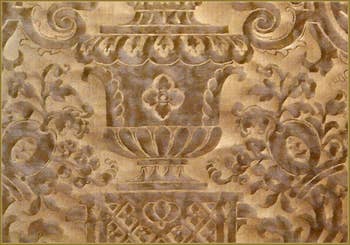
Tissu Fortuny Carnavalet At the Arts Déco exhibition at the Louvre in 1911, Mariano Fortuny presented his collections of printed fabrics and garments: tunics, scarves, shawls, veils, coats, dresses.
“A little corner full of light and colour... fabrics, cloths, veils by Mariano Fortuny. Fabrics printed in Venice, copied from antiquity, harmony of patterns and colours.”
Then Bice, the author of these lines, recalls Cécilia Fortuny's collection of antique fabrics, which he had seen the previous year:
“It was last year in Venice. It was a bright May morning all in bloom and fragrant, a wave of memories awakened in me that moment... when I found myself in a superb salon where the mistress of the house and her children were doing me the honours. [...]
Tissus Fortuny In one corner were hidden the most beautiful antique fabrics I had ever seen in my life, and as I bent down I unconsciously looked for bloodstains, tears caused by a sword blow... nothing... in the middle of the living room they formed opulent piles, soft mattresses on which one dreamed of throwing oneself and it was a wild desire to plunge my arms up to my shoulders into the warm entrails of these fabrics. [...]
What a joy for sight and touch! What a compensation compared to the gloomy modern fabrics, the sad contemporary clothes devoid of colour!
And so, as I entered the Arts Déco exhibition at the Louvre on a fine April day, I saw the miraculous fabrics of the Palazzo Martinengo at the back of the gallery...
What a joy it was to see Mr Fortuny again: Did you bring all your fabrics from faraway Venice?
He smiled, picking up a few pieces of cloth from the floor.
And I saw, full of admiration, that they were printed fabrics arranged, imagined by his artistic mind.
Fabric Cushions Fortuny Old fabrics certainly have no more vivacity, nor more character than these, nor are they richer or more varied.”
Bice - “Le Industrie Feminili Italiane” - Quarterly bulletin for April, May, June 1911
The “revival”, was therefore perfectly successful!
Through the brilliance of the golds and colours, the quality and beauty of Mariano Fortuny's fabrics, the narrator recaptured that delightful moment when he discovered these precious fabrics that aroused both his curiosity and his sensuality.
And now, the magic of Mariano Fortuny has made them reappear as beautiful, fascinating and attractive as ever, but all new.
These were not mere copies of the old, but the recapture of the quality of the fabric, the beauty of the old motifs and the brilliance of the colours, to recombine or mix them according to his whim and present them in an entirely new and original form.
The pleasure of remembering is doubled by the happy surprise: the evocative power of the return of the old in a form that is both the same and different, is that of a return to the past that sends us back to our present, which it has made more familiar.
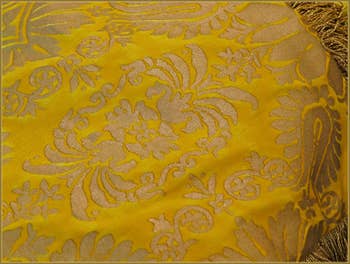
Fortuny Fabric Cushion
Fortuny fashion: timeless style inspired by art from around the world
“Fortuny was able to anticipate the new fashion and second it: I have seen the most elegant ladies wearing these fantastic veils that veil the silhouette of the body while softening its contours [...]
Today's fashions favour fabrics inspired by antiquity, the beautiful lines of Byzantine art, the poetry of Turkish motifs, and the elegance and harmony of the Italian Renaissance.
These fabrics seem like a breath on which golds and colours have been printed.”
“Bulletin Industrie Feminili Italiane” Second Quarter 1911
His success was already heralded by the fact that ladies from the world of show business and high society were already wearing clothes bearing his signature : La Duse, Sarah Bernhardt, Gabrielle Rejane, Isadora Duncan, Julia Marlowe, the Marquise Luisa Casati, the Marquise de Polignac...
As “models” ambassadors to the international elite of which they are a part and to which they bring a new style, rich in prestigious references, and good taste.
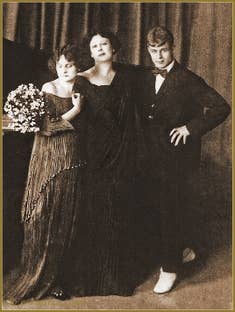
Irma Duncan in dress “Delphos” Mariano had begun by painting and the stage with the quest for the total work of art where costumes and sets are in perfect harmony with the work represented.
By resurrecting the beautiful things of the past in entirely new forms, his eclectic spirit re-established the correspondence and harmony between the luxury of the fabrics and the architecture of Venice: a life-size rehearsal, and Venice rediscovers its past.
Not only his dresses, but also his magnificent burnous, shawls, jackets and djellabas also made Mariano Fortuny famous, whose eclecticism was always combined with a theatrical representation of his models, seeking effects by closely associating them with a context that perfectly enhanced them.
Destined for a certain international elite, these were not simple garments, but unique pieces, original works that could find no better place to be worn than in a city unique for the richness and originality of its architecture.
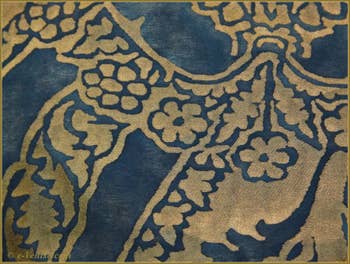
Detail of a Mariano Fortuny fabric
“For Fortuny's dresses, we had finally settled on a blue and gold with pink lining, which had just been finished.
And I'd still ordered the five she'd regretfully given up, out of preference for that one.
But when spring came and two months had passed since her aunt had told me, I let my anger get the better of me one evening.
It was precisely the evening when Albertine had first put on Fortuny's blue and gold dressing gown, which, by reminding me of Venice, made me feel even more what I was sacrificing for her, who knew nothing about it.
Although I had never seen Venice, I dreamt of it constantly, ever since those Easter holidays I must have spent there as a child, and even earlier, ever since the engravings by Titian and the photographs by Giotto that Swann had once given me at Combray.
The Fortuny dress Albertine wore that evening seemed to me like the tempting shadow of that invisible Venice.
Fortuny Fabrics It was invaded by Arab ornamentation, like the palaces of Venice concealed in the manner of sultanas behind an openwork veil of stones, like the bindings of the Ambrosian Library, like the columns from which the oriental birds that alternately signify death and life, were repeated in the shimmer of the fabric, a deep blue that, as my gaze moved along it, changed into malleable gold by the same transmutations that, in front of the gondolas that move forward, change the azure of the Grand Canal into flaming metal.
And the sleeves were lined with a cherry pink, which is so particularly Venetian that it is called Tiepolo pink.”
Marcel Proust - La Prisonnière
So it was only natural that Venice should be the place to showcase them, and this at a time when, thanks to the Biennale, the installation of the Ciga on the Lido and the development of tourism, Venice wanted to compensate for the shortcomings of its economic fabric and the impoverishment of its population by showcasing the richness of its historical-artistic heritage and the poetry of its urban structure.
Indeed, in the last decades of the 19th century Venice had become a kind of refuge for celebrities such as Byron, Shelley, Stendhal, Alfred de Musset, John Ruskin, Robert Browning, Wagner....
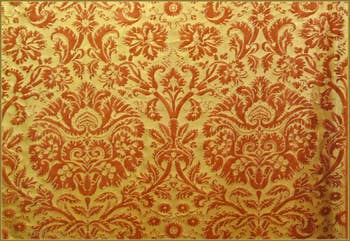
Fabric “de Medici” But also a fashionable place for the delights and sufferings of a host of people from the snobs who followed the big names of the Almanach Gotha, or the international stars (virtuosos, writers, actors), to those seeking a more intense life.
And everyone saw and experienced Venice in their own way.
The case of the writer Von Aschenbach, hero of the novel “Death in Venice” by Thomas Mann which later inspired the superb film by Visconti, gives us a magnificent example of this.
Masked parties had become fashionable in Venice at the time.
And Mariano Fortuny was nicknamed “the magician of Venice” or “the little Leonardo” because his inventions, his sets and above all his marvellous dresses and costumes that enlivened these many parties, restored the Venetian palaces to all their splendour of the time of the Serenissima.

Mariano Fortuny Autorportrait
“Like those doges whose velvet robes he wore to the Persian balls that were all the rage in Paris, Mariano Fortuny, on leaving his studio, invited us to his mother's house, opposite the miniature palace rented by Réjane; Mme Fortuny offered us snacks worthy of the Parmesan.
Her table covered in Venetian stitch was a veritable fruit market, peaches on embossed copper dishes alternating with falbalas of golden, ribboned pastry sprinkled with flour sugar, whose Venetian name I have forgotten.
Proust had been received there, eight years earlier; he had known Fortuny; later he was to give many dresses by this artist to La Prisonnière; they have entered Proustian legend.”
Paul Morand - Venices - published by Gallimard, Collection the Imaginary
Fortuny Martinengo Orfei | Theatre | Clothes Fabrics | Photography Costume
Painters Tintoretto | Titian | Canaletto | Fortuny | Albrecht Dürer |
Art Painters | Music | Literature | Video | Pictures
Back to Top of Page




